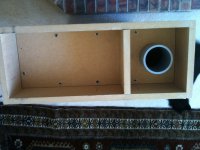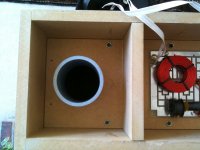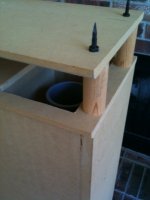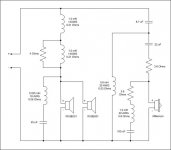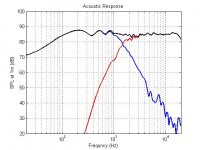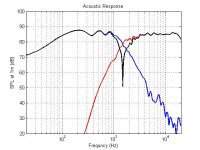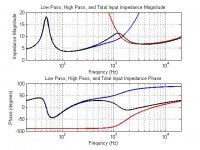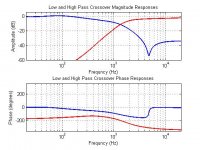I'm building a fat thor. Almost complete with the fabrication and construction however when I put the front panel on I noticed that I made a huge mistake. My speaker cut outs are exactly 6" below where they should be. My question is: Will the new speaker locations cause a problem other than simply not being at listening level?
Oh, I'm using 1" MDF for the front panel and I'm out of 1" MDF. I used 1" all the way around because I didn't want to make the braces. The internal volume is the same as used in the 3/4" design.
Hope someone out there can help me.
Oh, I'm using 1" MDF for the front panel and I'm out of 1" MDF. I used 1" all the way around because I didn't want to make the braces. The internal volume is the same as used in the 3/4" design.
Hope someone out there can help me.
Ah hah! Man I'm a genius. OK. To fix this all I do is cut 6" from the top of the panel and simple glue it to the bottom. Now my speakers aren't 6" too low.
Thanks everyone.
"Ideas may drift into other minds, but they do not drift my way.
I have to go and fetch them. I know no work manual or mental to equal the
appalling heart-breaking anguish of fetching an idea from nowhere."
Thanks everyone.
"Ideas may drift into other minds, but they do not drift my way.
I have to go and fetch them. I know no work manual or mental to equal the
appalling heart-breaking anguish of fetching an idea from nowhere."
Oh, I'm using 1" MDF for the front panel and I'm out of 1" MDF. I used 1" all the way around because I didn't want to make the braces.
The braces are still needed... thicker material does nothing to brace the drivers to the back of the box.
dave
Greetings!
Sorry if I’m posting at the wrong place but I would like to say thanks to Scottmoose, Planet10 and Martin J King for the excelent work done with the Small, Short and Fat Thor project.
Recently I’ve made a clone of the Small Thor speakers, using the same cabinet except for the drivers. I’m using 2 mids from Akronaudiotec (Akron KB6 - AKRONAUDIOTEC - Accesories and DIY - Mid Bass Akron KB6) and a Hiquphon OW4 tweeter.
The idea came up when I was playing with Martin’s worksheets and noticed that these drivers performed very similar to the SEAS Excel at the Small Thor cabinet.
Here some photos during the DIY Fest Rio:
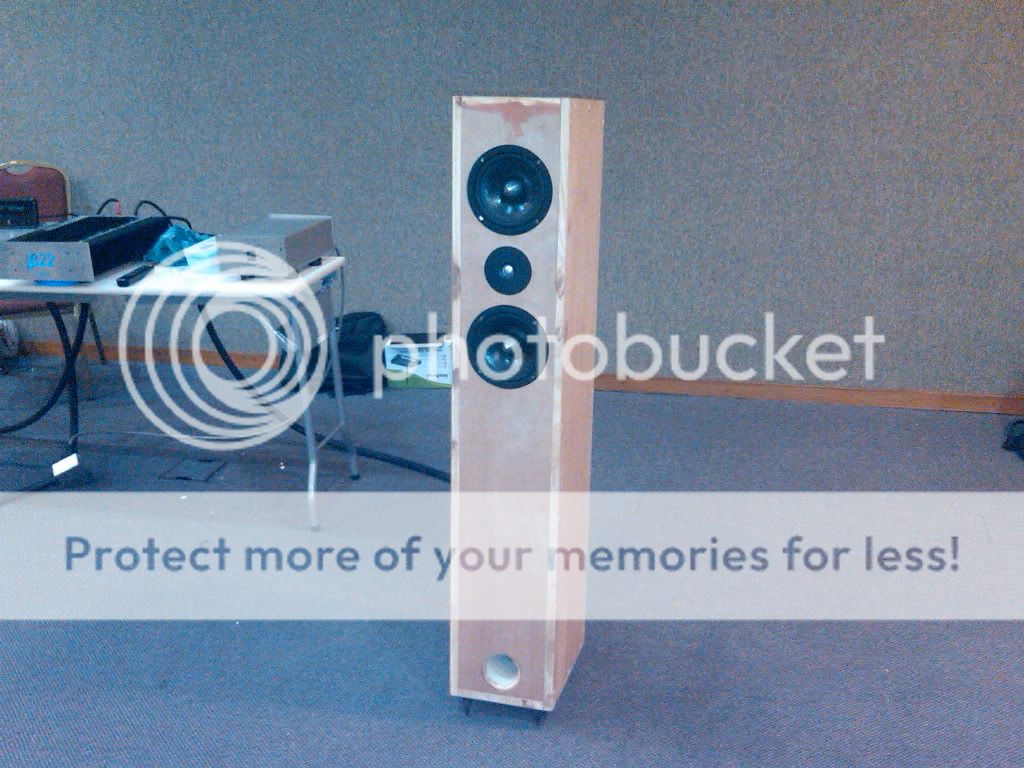

Outstanding performance!!!
Regards,
Mutuano
Sorry if I’m posting at the wrong place but I would like to say thanks to Scottmoose, Planet10 and Martin J King for the excelent work done with the Small, Short and Fat Thor project.
Recently I’ve made a clone of the Small Thor speakers, using the same cabinet except for the drivers. I’m using 2 mids from Akronaudiotec (Akron KB6 - AKRONAUDIOTEC - Accesories and DIY - Mid Bass Akron KB6) and a Hiquphon OW4 tweeter.
The idea came up when I was playing with Martin’s worksheets and noticed that these drivers performed very similar to the SEAS Excel at the Small Thor cabinet.
Here some photos during the DIY Fest Rio:


Outstanding performance!!!
Regards,
Mutuano
Mutuano -- finding less expensive but comparable drivers paves the way for even greater use of this schema. Congrats!
Scott & i have also just done a commission for a VIFA P17 Thor-alike. Not road-tested yet thou.
dave
Hi Dave!
That is an interesting project for sure.
One thing that I’ve noticed in this clone is the tremendous low frequency output. I’m still amazed with how low and loud this loudspeaker can go!!!
So that’s keep me wondering what is going to happen when I fire this speakers in my small room (it’s a 10X10ft room)…
The speaker is now with the guy who designed the x-over.
Because of that I’m already simulating a new MTM using a 5” drive instead of the current 6,5”, the Scan-Speak 15W/8530K01.
The simulations are not finished yet and you will probably see them at Martin’s Yahoo Group for discussions.
Many thanks once again!
Regards,
Mutuano
That is an interesting project for sure.
One thing that I’ve noticed in this clone is the tremendous low frequency output. I’m still amazed with how low and loud this loudspeaker can go!!!
So that’s keep me wondering what is going to happen when I fire this speakers in my small room (it’s a 10X10ft room)…
The speaker is now with the guy who designed the x-over.
Because of that I’m already simulating a new MTM using a 5” drive instead of the current 6,5”, the Scan-Speak 15W/8530K01.
The simulations are not finished yet and you will probably see them at Martin’s Yahoo Group for discussions.
Many thanks once again!
Regards,
Mutuano
Comments please ....
Just read an interesting review over at 6moons,
http://www.6moons.com/audioreviews/aurelia/aurelia_2.html
Just read an interesting review over at 6moons,
In the 1970s, Joseph D'Appolito created an acoustical array of two mid/woofers symmetrically arranged above and below the tweeter in a vertical alignment. The main purpose was to eliminate lobing errors in multi-way speakers. Increasing vertical directivity wasn't initially important. Under certain conditions where poor listening room acoustics normally ruined the sound, one soon observed improved imaging and sound quality with this alignment. After more critical investigations, certain problems became evident as well. A D'Appolito system sounded vertically unstable and vague with even the slightest movement in the listening position. Thought the D'Appolito array today still has its supporters, most manufacturers ignore its strengths due to its compromises. The main problems with the D'Appolito configuration are:
• Interference at the crossover frequency: In most cases the distance between the radiating surfaces of the mid/woofers is larger than the crossover frequency's wavelength. This causes strong interference while moving in the vertical axis. Once you add a tweeter into this mess, the result is an acoustically very unstable behavior in the vertical axis.
• Different kinds of waveform behavior between tweeter and mid/woofers: Personally I find the even bigger problem to be that in a traditional D'Appolito configuration, the tweeter operates as a spherical radiator whilst the two symmetrical midranges tend to generate cylinder waves at the crossover frequency. While a cylinder wave fades at 3dB over distance, this doubles with a spherical wave to 6dB. The result is output instability over listening distance. To correctly balance a D'Appolito system is pretty difficult. Even in the best case the result will be more or less unstable. Is there a way to get a D'Appolito array to work properly?
http://www.6moons.com/audioreviews/aurelia/aurelia_2.html
In the 1970s, Joseph D'Appolito created an acoustical array of two mid/woofers symmetrically arranged above and below the tweeter in a vertical alignment.
Joe's AES paper was Fall 1983. So the above should be "In the 1980s,"
I built my 1st one of these in 1975. A pair of Harbeth 8" woofers & a Philips tweeter in a triangulated TL.
You can get around the issues that 6 moons brings up by using a tweeter that can XO really low. 300-500 Hz pushes the XO into an area where wavelengths are long enuff that the physical separation isn't an issue.
dave
You can get around the issues that 6 moons brings up by using a tweeter that can XO really low. 300-500 Hz
dave
Any suggested low distortion tweets, that can cross at 6dB/Oct. ?
Fostex FF85KeN, any of the 2nd generation Mark Audio Alpairs. 6 or 7 would be my choice (i'm extrrapolating on the 6 -- Mark has only made prototypes so far, the 7 is eerie good, at least as good as the FF85KeN, but more dynamic capability & higher efficiency). Also still made with promise to continue to improve).
dave
dave
First off I've read thru numerous thread here and at HTGuide and I want to thank everyone for all the excellent info that this newbie is trying to digest.
I'm planning on building a pair of Odin's for my office. The various recommended Thor cabinets are just too big for my space. I'll initially be driving them with an Emotiva XPA-2 borrowed from the HT, but will probably purchase a pair of UPA-1's in the near future. I'm going to have Madisound build the LR4 XO's since I live in the same town and don't have that skill. Luckily I've built quite a few built-in cabinets throughout the house and have all the tools necessary to do the woodworking.
I have a couple of questions based on what I've read.
Jimangie has stated that he has stuffed his port so that they are basically sealed. I'm planning on using the standard SEAS Odin design spec.
1) Should I fore-go the port entirely or should I keep it to allow for some flexibility?
And lastly, someone stated that they were working with Madisound on creating a XO to Jimangie's LR4 design, but Madisound wasn't able to match it perfectly based on parts availability. It also sounded like Adam is the guy to talk to.
2) Was a suitable design based on their parts availability reached by anyone to serve as a guide?
Thanks again for everyone's contributions to this thread. It was a long read and I was up 2:00am last night doing so, but it was also very informative and interesting.
Greg
I'm planning on building a pair of Odin's for my office. The various recommended Thor cabinets are just too big for my space. I'll initially be driving them with an Emotiva XPA-2 borrowed from the HT, but will probably purchase a pair of UPA-1's in the near future. I'm going to have Madisound build the LR4 XO's since I live in the same town and don't have that skill. Luckily I've built quite a few built-in cabinets throughout the house and have all the tools necessary to do the woodworking.
I have a couple of questions based on what I've read.
Jimangie has stated that he has stuffed his port so that they are basically sealed. I'm planning on using the standard SEAS Odin design spec.
1) Should I fore-go the port entirely or should I keep it to allow for some flexibility?
And lastly, someone stated that they were working with Madisound on creating a XO to Jimangie's LR4 design, but Madisound wasn't able to match it perfectly based on parts availability. It also sounded like Adam is the guy to talk to.
2) Was a suitable design based on their parts availability reached by anyone to serve as a guide?
Thanks again for everyone's contributions to this thread. It was a long read and I was up 2:00am last night doing so, but it was also very informative and interesting.
Greg
I'm running mine completely sealed in a 1.2 cu ft cabinet 10 inches wide with a 1/2 inch roundover on the sides of the baffle. The bass is pretty good but a sub definitely improves things. I think the modeled bass response has a -3dB point of 50 Hz.
1) If want to go with the port, make the cabinets as big as you can. You could then play with the port length and dampen it further with cotton or similar if bass is too fat. I would recommend the cabinets 10" wide with the 1/2 inch roundovers as mine are.
2) For the crossover, Madisound should have all the parts needed. You can use the 14 AWG Solen inductors. If you're interested, I have another LR4 crossover design which crosses at 1.5 kHz. It has a few more parts than the 2 kHz LR4 design but it theoretically has lower distortion due to the 3rd harmonic peak at 1.6 kHz further attenuated. Both LR4 designs sound good.
1) If want to go with the port, make the cabinets as big as you can. You could then play with the port length and dampen it further with cotton or similar if bass is too fat. I would recommend the cabinets 10" wide with the 1/2 inch roundovers as mine are.
2) For the crossover, Madisound should have all the parts needed. You can use the 14 AWG Solen inductors. If you're interested, I have another LR4 crossover design which crosses at 1.5 kHz. It has a few more parts than the 2 kHz LR4 design but it theoretically has lower distortion due to the 3rd harmonic peak at 1.6 kHz further attenuated. Both LR4 designs sound good.
Thanks for the quick reply.
Unfortunately I already cut the blanks yesterday since I had some MDF lying around and some spare time. The box has a 9.5" baffle and is 1.18 cu ft without a brace so I think I'm going to go the sealed route. I'll cut some holes in the brace as well.
If I don't like it I can always build a bigger box and put a port in it. The practice won't hurt me. Ultimately I want to replace my 20 yr old Vandersteens in the HT with Clearwave Dynamic 4T's and the Odin's are practice before I build something bigger.
I'd be very interested in your 1.5Khz crossover design if you can point my towards a schematic. These first XOs I plan on having made for me, but I'd like to make my own at somepoint, but for now baby steps.
I'll be sure to post my thoughts once they are finished.
Thanks again for your help,
Greg
Unfortunately I already cut the blanks yesterday since I had some MDF lying around and some spare time. The box has a 9.5" baffle and is 1.18 cu ft without a brace so I think I'm going to go the sealed route. I'll cut some holes in the brace as well.
If I don't like it I can always build a bigger box and put a port in it. The practice won't hurt me. Ultimately I want to replace my 20 yr old Vandersteens in the HT with Clearwave Dynamic 4T's and the Odin's are practice before I build something bigger.
I'd be very interested in your 1.5Khz crossover design if you can point my towards a schematic. These first XOs I plan on having made for me, but I'd like to make my own at somepoint, but for now baby steps.
I'll be sure to post my thoughts once they are finished.
Thanks again for your help,
Greg
You may want to do a 2" flared port in the back. You could then start with a long length and cut it back and possibly dampen it to where the bass sounds right. This would give you flexability with the bass response. If you go sealed, you have only one option.
Here's the schematic for the 1.5 kHz LR4. I'll post response plots tomorrow.
I bought parts for this at Parts Express. Not sure if Madisound can make the 0.025 mH inductor.
In my crossover, the 3.6 Ohm is a 5.6 Ohm in parallel with at 10 Ohm, the 8.7 uF is an 8.2 uF in parallel with a 0.5 uF, and the 22 uF is a 20 uF in parallel with a 2 uF.
Here's the schematic for the 1.5 kHz LR4. I'll post response plots tomorrow.
I bought parts for this at Parts Express. Not sure if Madisound can make the 0.025 mH inductor.
In my crossover, the 3.6 Ohm is a 5.6 Ohm in parallel with at 10 Ohm, the 8.7 uF is an 8.2 uF in parallel with a 0.5 uF, and the 22 uF is a 20 uF in parallel with a 2 uF.
Attachments
Last edited:
- Home
- Loudspeakers
- Multi-Way
- Clarity on Seas Thor Kit
